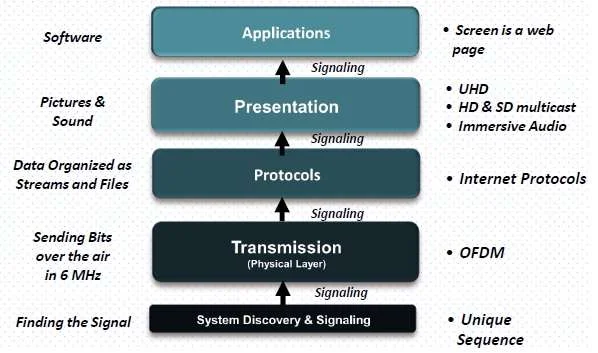Television basics tutorial-TV Signal Spectrum
This page on television basics tutorial covers TV Signal spectrum depicting both audio and video signals. It also provides link to TV channel frequencies, cable TV basics, satellite TV basics, digital television basics, cable TV channel frequencies, DTV standards, VSB modulation, difference between DVB-T, DVB-C, DVB-S and DVB-H systems etc.

As we know TV signal consists of two components voice and picture. Figure depicts complete TV signal mentioning both picture and sound carriers. The entire TV signal will have bandwidth of about 6 MHz.
As shown in th figure, sound carrier is at the upper end of the spectrum and picture carrier is at the lower end of the spectrum. Frequency modulation is used to modulate sound signal on the carrier. The audio bandwidth of signal is from 50 Hz to 15 KHz.
Video signal obtained from the camera is amplitude modulate on picture RF carrier.
Picture carrier is 4.5 MHz less than the sound Carrier. The video signal can contain frequency components of upto 4.2MHz. Hence if both the sidebands need to be transmitted than it will occupy 8.4MHz. Vestigial sideband transmission is used to conserve the bandwidth of video signal part. In vestigial sideband AM modulation, full upper sideband is transmitted but lower sidebands is reduced to conserve bandwidth.
TV signals are transmitted in 54 to 806 MHz frequency range. Refer Digital TV basics for more information.
ATSC 3.0 Latest Digital TV Standard

This ATSC 3.0 tutorial covers basics of ATSC 3.0 TV technology including features. It mentions ATSC 3.0 protocol stack, ATSC 3.0 Physical layer,
ATSC 3.0 Frame structure and ATSC 3.0 advantages or benefits.
Follow ATSC 3.0 tutorial➤.
TV RELATED LINKS
Television basics tutorial TV channel Frequencies Cable TV basics Cable TV channel frequencies Satellite TV basics Digital TV basics DTV standards VSB modulation Cable TV vs Satellite TV vs Digital TV DVB-T vs DVB-S vs DVB-C vs DVB-H
